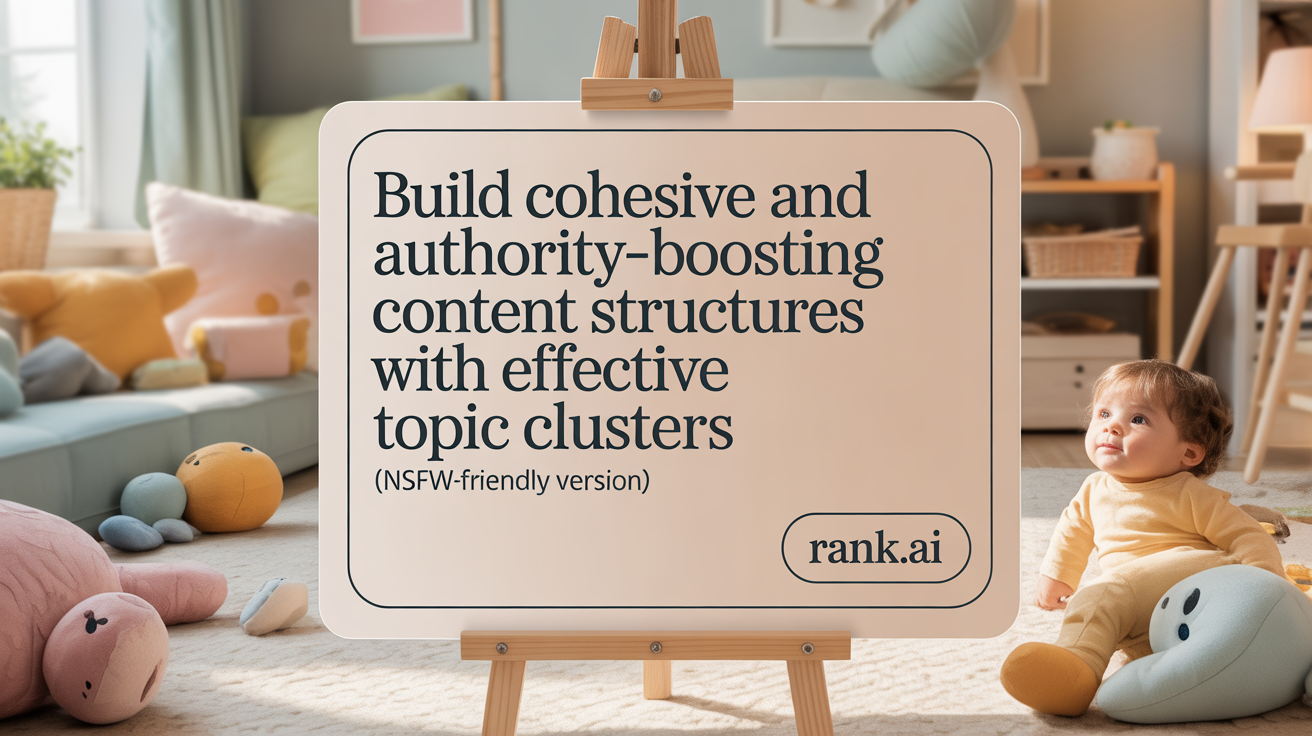Understanding Topic Clusters: The SEO Content Revolution
In the evolving landscape of SEO and content marketing, topic clusters have emerged as a powerful strategy to improve content discoverability, user engagement, and search engine rankings. This article delves into the core concepts, components, benefits, and best practices of topic clusters, revealing how structured content organization can elevate your website’s authority and visibility.
What Are Topic Clusters and How Do They Work?

What are topic clusters and how do they work?
Topic clusters are an organized content strategy central to modern SEO and digital marketing. They involve grouping related pages and articles around a main theme, creating a web of interconnected content that enhances website authority and discoverability.
At the core of a topic cluster is the pillar page. This page serves as a comprehensive, high-level overview of a broad topic. It provides essential information and links prominently to several supporting pages or cluster pages. These cluster pages focus on specific subtopics, diving deeper into particular aspects related to the main theme.
The internal linking structure is crucial. Each cluster page links back to the pillar page, and the pillar links to each cluster page. This interconnected network helps search engines understand the relationship between pages and the overall topic. It signals to Google and other search engines that the website is an authority on the subject.
Effective topic clusters also involve strategic keyword research. By identifying both broad and long-tail keywords, content creators can develop relevant pillar and cluster pages targeting various user intents. This makes the website more visible across a range of search queries.
Besides improving SEO, topic clusters enhance user navigation. Visitors can easily find related content, explore subtopics, and stay engaged longer. This better organization boosts user experience and increases the likelihood of content sharing and backlinks.
In essence, topic clusters help websites rank higher by demonstrating topical expertise, authority, and trustworthiness. They structure content in a way that aligns with search engine algorithms while providing a streamlined experience for users. Proper implementation involves choosing relevant core topics, creating quality content, and maintaining a logical internal linkage network to ensure ongoing relevance and performance.
Core Components and Structure of Effective Topic Clusters

What components and structure make an effective topic cluster?
An effective topic cluster is built around a central pillar page that acts as the main hub, providing a broad overview of a core subject. This pillar page addresses various user intents and serves as the foundation for the entire cluster.
Supporting this are multiple cluster content pages focused on specific subtopics or niches within the main theme. These pages offer detailed, targeted information that reinforces the authority of the cluster.
Strategic internal linking is crucial. Each cluster page links back to the pillar page and to other relevant cluster pages. This internal link structure helps search engines understand the content hierarchy, signals topical relevance, and improves navigation.
The structure also considers coverage of different user intents, ensuring content addresses questions and concerns at various stages of the buyer’s journey—from awareness to decision.
Keyword optimization is integrated into each page, with targeted short-tail and long-tail keywords woven naturally into content, meta descriptions, and headers. This enhances visibility for a range of search queries.
Organizational hierarchy is maintained through a clear, logical structure. The pillar page provides a broad overview, with cluster pages organized around specific subtopics that support the overall content theme.
Overall, the goal is to create a cohesive, interconnected web of content that improves SEO, provides value to users, and establishes authority around a core subject.
How Topic Clusters Boost SEO Authority and Content Marketing Success

How do topic clusters contribute to building SEO authority and content marketing success?
Topic clusters play a crucial role in enhancing a website's SEO authority and overall content marketing effectiveness. By creating a central pillar page that thoroughly covers a broad subject, websites demonstrate deep expertise and signal authority to search engines. This pillar page acts as the hub, linking to related subtopic pages—known as cluster content—that delve into specific aspects of the main topic.
This interconnected structure helps search engines understand the relationship between content pieces, making it easier to index and rank the site for various relevant keywords. Targeting both broad keywords and more specific long-tail keywords allows the site to attract diverse traffic, covering multiple search intents. Such organization also improves site architecture, making navigation smoother for users and search engines alike, which can lead to increased engagement and higher rankings.
Moreover, well-integrated topic clusters address different user needs at various stages of their journey, fostering a comprehensive content ecosystem. As users find all relevant information within a clear and organized structure, their experience improves, increasing trust and the likelihood of return visits.
Importantly, implementing these clusters aligns with Google's E-E-A-T standards—Experience, Expertise, Authority, and Trustworthiness—by showcasing in-depth knowledge and consistent quality. This focus on authoritative content builds credibility, which is rewarded with better rankings and higher visibility.
In summary, topic clusters support content marketing success by solidifying a site's reputation as a reliable source, boosting organic traffic, and strengthening overall SEO authority through strategic, interconnected content development.
Key Benefits of Using Topic Clusters for SEO and Discoverability

What are the benefits of using topic clusters for SEO and content discoverability?
Implementing topic clusters provides multiple advantages that can significantly enhance a website’s SEO and how easily content can be found. One of the main benefits is improved site architecture. Organizing content into a well-structured network of a central pillar page linked to related subtopic pages helps search engines understand the relevance and hierarchy of your content.
This internal linking strategy not only boosts your site’s authority but also makes it easier for search engines to crawl and index your pages properly. As a result, your website gains better visibility in search results.
Another advantage is keyword optimization. Topic clusters allow you to target a wide array of keywords, especially long-tail keywords, which are more specific and often less competitive. This diversification helps your content rank for various search intents and covers topics comprehensively.
From a user experience perspective, topic clusters make navigation smoother and more intuitive. Visitors can easily explore related content, which encourages them to stay longer on your site. As engagement increases and bounce rates decrease, search engines interpret this as a sign of valuable content, further improving your ranking.
Overall, adopting a topic cluster model supports ongoing SEO success by making your website more organized, authoritative, and user-friendly. This structure not only enhances discoverability but also positions your content as a comprehensive resource that meets various user needs.
Examples and Models of Content Topic Clusters
 There are several effective ways to structure content using topic clusters, each serving different strategic purposes.
There are several effective ways to structure content using topic clusters, each serving different strategic purposes.
One common example is the "Optimize Your YouTube Videos" cluster. This type of cluster usually contains a central pillar page that provides a broad overview of optimizing videos for YouTube, including topics like keyword research, crafting compelling titles and descriptions, increasing viewer engagement, and analyzing performance metrics. Supporting pages dive deeper into each subtopic and link back to the main pillar, forming a strong internal network.
Another popular model is the hub and spoke structure. In this setup, a main hub page acts as a comprehensive resource on a broad theme, such as "Digital Marketing Strategies," linking to several supporting pages or 'spokes' that focus on specific aspects—content marketing, social media, SEO, email marketing, etc. This layout helps both users and search engines navigate related content efficiently.
Content directories and subject guides are also common forms of clusters. These are collections or listings of related resources, articles, or pages curated around a central theme, such as an industry-specific knowledge base or a resource center. They organize content systematically, making it easier for visitors to find relevant information quickly.
Verticalized clusters focus on specialized topics within a particular industry or niche, such as healthcare, finance, or legal services. These clusters provide in-depth, tailored content that appeals to niche audiences and helps establish industry authority.
Collectively, these models aim to improve SEO performance by demonstrating topical authority, enhancing website structure, and making it easier for search engines to understand the relationships between different content pieces. They also improve user experience by facilitating easier navigation, increasing engagement, and targeting a wide range of keywords across various search intents.
Best Strategies and Practices for Creating Effective Topic Clusters
What are the best strategies and practices for creating effective topic clusters?
Creating impactful topic clusters involves several well-planned steps aimed at organizing content for maximum SEO benefit. The first step is selecting a core topic or pillar page. This page should be broad enough to cover the main subject comprehensively but focused enough to target relevant keywords.
Next, comprehensive keyword research is essential. Utilizing tools like SEMrush, Ahrefs, or Google Keyword Planner helps identify high-volume, relevant subtopics and long-tail keywords related to the main theme. This research guides the creation of supporting pages that delve into specific aspects or user intents.
Develop a pillar page that acts as a central hub offering a broad overview of the main topic. This page should include clear, concise information and links to detailed cluster pages. Supporting pages—also known as cluster content—should cover subtopics in detail, each optimized around targeted keywords.
A crucial component of effective topic clusters is internal linking. Hyperlinking from cluster pages back to the pillar page and vice versa signals relevance and authority to search engines. Strategically placing links helps enhance navigation and distributes PageRank across the cluster.
Monitoring performance is vital, so utilize SEO tools like SEMrush’s Position Tracking, Google Analytics, or Search Console to analyze keyword rankings, organic traffic, and engagement metrics. Regular reviews enable ongoing optimization.
Finally, focus on content quality and relevance. Ensure all pages provide valuable, accurate information, maintain consistency in tone and style, and stay updated with the latest data and trends. Rich, semantic linking and thoughtful organization will maximize both SEO performance and user experience.
Overall, creating effective topic clusters is a dynamic process that combines strategic planning, continuous analysis, and high-quality content creation to help your website rank better and serve your audience more effectively.
Role of Internal Linking in Topic Clusters for SEO and User Experience
Significance of Internal Links
Internal links are fundamental to the success of a topic cluster strategy. They connect the pillar page with its related cluster pages, creating a cohesive content network. This structure helps search engines understand the relationship between different pages, establishing a clear hierarchy and topic relevance.
Distributing Link Equity
One of the advantages of internal linking within clusters is the efficient transfer of link equity. When authority flows through these links, it boosts the ranking potential of all associated pages. Proper internal linking ensures that the most important pages, like the pillar page, receive sufficient authority to rank higher.
Enhancing Crawlability
Search engines crawl websites by following links. Well-structured internal links in a topic cluster facilitate easier crawling, making it simpler for search engines to discover and index all related content. This improved crawlability can lead to better visibility in search results.
Improving Site Navigation
Internal links also enhance user experience. When visitors can easily navigate between related pages, they stay longer on the site and find relevant information more efficiently. Linking pillar pages with cluster content helps guide users through the topic seamlessly.
Signaling Importance to Search Engines
Strategic internal linking signals the importance of certain pages within a website. By linking from high-authority pages to important cluster pages, webmasters can reinforce their relevance. This signaling helps search engines prioritize pages and improve overall site ranking.
Linking Pillar and Cluster Pages
The core practice involves linking the comprehensive pillar page to detailed cluster pages covering specific subtopics, and vice versa. These connections not only organize content but also pass ranking signals, helping search engines comprehend the full scope of the content.
Implementing effective internal links as part of your topic cluster strategy is vital for maximizing SEO benefits and providing a positive, easy-to-navigate experience for users. Regularly reviewing and updating internal links ensures that the content remains logically connected and optimized for search performance.
How Topic Clusters Improve Content Discoverability for AI and Humans
How do search engines understand content within topic clusters?
Search engines, like Google, interpret topic clusters by analyzing internal links and the relationships between the pillar page and related sub-topic pages. This structured linking helps search engines grasp the hierarchy and relevance of the content, establishing the site’s authority on the main subject.
What role do semantic relationships play in topic clusters?
Semantic relationships, created through interconnected pages and related keywords, enable search engines and AI systems to comprehend the meaning of content more effectively. These relationships form a web of related concepts, improving the accuracy of content retrieval and relevance.
How do topic clusters support AI content generation and retrieval?
By organizing content into clear, linked groups, topic clusters assist AI systems in understanding the context and scope of a subject. This organization simplifies content retrieval, makes AI-driven content recommendations more accurate, and allows for better content generation aligned with user intent.
How do topic clusters enhance human navigation?
For users, well-structured clusters streamline navigation by providing logical pathways through related content. Visitors can easily find additional information on specific subtopics linked from the primary pillar page, reducing frustration and increasing engagement.
In what ways do topic clusters improve relevance and access to information?
Organized clusters encompass a comprehensive set of related keywords and subtopics, ensuring content coverage aligns with various user queries. This broad yet targeted approach boosts relevance, making it easier for both search engines and users to locate pertinent information quickly.
How do topic clusters promote better user comprehension?
By presenting related content in an interconnected, hierarchical structure, topic clusters help users grasp complex subjects more easily. Multiple related pages reinforce key concepts and provide in-depth coverage, supporting better understanding and retention.
Implementing well-structured topic clusters significantly enhances content discoverability. They improve how AI systems interpret and retrieve information, while also offering users a more organized, engaging, and relevant browsing experience. Ultimately, this strategic content organization benefits everyone—search engines, AI systems, and human visitors alike.
Continuous Maintenance and Optimization of Topic Clusters for Long-Term Success
How to monitor SEO performance of your topic clusters
Monitoring the effectiveness of your content clusters is essential. Track keyword rankings, organic traffic, and backlinks to see how well your clusters are performing. Tools like Google Analytics and Ahrefs help analyze traffic patterns and page authority.
Updating and refreshing content regularly
To keep your clusters relevant, update existing content periodically. Refresh outdated facts, add new subtopics, and optimize for the latest keywords. This ongoing effort signals freshness to search engines, boosting your rankings.
Analyzing user engagement metrics
User engagement metrics, such as time on page, bounce rate, and pages per session, provide insight into how visitors interact with your content. High engagement typically indicates content relevance and quality, guiding your optimization efforts.
Identifying and addressing content gaps
Regularly review your content landscape to spot gaps where user questions or search queries are not fully answered. Use keyword research and user questions to create new cluster pages or expand existing ones, enhancing comprehensiveness.
Common mistakes to avoid when maintaining clusters
Avoid neglecting internal links or overloading clusters with low-quality content. Inconsistent update frequency or ignoring user feedback can weaken your authority. Maintain a cohesive content quality and cohesive linking structure.
How to sustain your topical authority
Consistently add valuable, in-depth content that covers your central topics comprehensively. Building authoritative content over time, along with strategic link building, will enhance your site's credibility and ranking.
Staying competitive amid evolving SEO landscapes
Search engine algorithms continually change. Stay informed about SEO trends and update your strategies accordingly. Leveraging new tools and insights ensures your clusters remain aligned with best practices and user expectations.
Regularly maintaining your topic clusters through these practices helps secure long-term SEO success. It ensures that your content remains relevant, authoritative, and accessible, fostering trust among users and search engines alike.
Tools and Techniques to Support Topic Cluster Development
To effectively create and optimize topic clusters on your website, leveraging the right tools and techniques is crucial. Keyword research tools such as Keyword Grouper Pro can help identify relevant keywords and group them into coherent clusters, making it easier to plan your pillar and cluster pages.
Question analysis tools like AlsoAsked allow you to explore common user questions related to your core topics. This ensures your content directly addresses what your audience is searching for, improving relevance.
Tracking SEO performance is vital for assessing the success of your content clusters. Tools like SE Ranking enable monitoring of keyword rankings, organic traffic, and backlinks, providing insights into how well your clusters are performing and where adjustments are needed.
A practical content mapping method involves creating a visual diagram or spreadsheet that links pillar pages with related cluster pages. This visual organization helps maintain a clear internal linking structure, ensuring that each supporting page effectively enhances the authority of the pillar.
Enhancing keyword grouping by combining insights from multiple tools can improve the relevance of cluster topics. You can refine your groupings by analyzing search intent, competition levels, and search volume.
To optimize cluster relevance, regularly update your content based on performance data and evolving search trends. Continuously refine internal links and add new content to cover emerging subtopics.
Popular tools like Keyword Grouper Pro and AlsoAsked are examples that can streamline these processes, making it easier to build comprehensive, well-structured topic clusters. Combining these tools with your content strategy boosts your SEO efforts, increases organic visibility, and helps build authoritative site content.
When implementing these techniques, remember that creating high-quality, relevant, and well-connected content remains the foundation of a successful topic cluster strategy.
Combining Topic Clusters with Backlinks to Maximize SEO Authority
Why are backlinks important for SEO?
Backlinks, also known as inbound links, are links from external websites that point to your content. They are a major factor in search engine algorithms because they serve as votes of confidence, showing that your content is credible and reputable.
How do external endorsements enhance your content?
Having backlinks from authoritative sources acts as an endorsement that signals trustworthiness to search engines. This not only boosts your SEO rankings but also helps in building your website’s overall credibility in the eyes of users.
Building credibility through backlinks
To establish a strong backlink profile, focus on acquiring links from reputable, relevant websites. Make sure your content is high-quality, as valuable and well-researched pages are more likely to be referenced by others.
Increasing content trustworthiness and user trust
When search engines see multiple trustworthy sites linking to your topic cluster, it enhances your page’s perceived authority. For visitors, external links to authoritative sources also improve trust, reinforcing the quality of your content.
Boosting SERP performance with a combined approach
Integrating backlinks with a well-structured topic cluster strategy creates a powerful SEO boost. Internal links help organize your content for better crawling and indexing, while backlinks increase your domain authority, leading to higher search rankings.
Synergizing internal and external SEO strategies
While internal links within your cluster improve navigation and content relevance, backlinks from external sites expand your reach and authority. Together, they create a comprehensive framework that supports long-term SEO success.
In summary, combining robust internal linking through topic clusters with strategic backlinks from reputable sources is essential for maximizing your site’s search engine authority and ensuring higher rankings and better visibility.
Elevating Content Discoverability Through Topic Cluster Mastery
Effectively implementing topic clusters transforms website content into an organized, authoritative, and highly discoverable resource. By strategically developing pillar pages linked to focused cluster content, and maintaining continuous optimization supported by powerful tools, businesses enhance both user experience and search engine performance. Combining this structure with quality backlinks further amplifies SEO authority, driving organic traffic growth and content marketing success. Embracing topic clusters is essential for any website aiming to improve content discoverability and achieve sustained digital prominence.
References
- How Topic Clusters Improve Your SEO and Content Strategy
- Topic Clusters 101: How to Level Up Your SEO (with Examples)
- Why Topic Clusters Are Important for Your SEO Strategy
- Mastering Topic Clusters: A Comprehensive Guide for Content ...
- Mastering Topic Clusters for AI-Driven SEO and Human-Centric ...
- SEO Topic Clusters: 6 Tips to Boost Your School's Strategy
- SEO Topic Clusters — How to Build a Content Cluster Strategy
- SERP ranking improvement! The Power of Topic Clusters and ...
- How To Build A Topic Cluster To Boost Traffic & Authority - Frase AI
- 7 Tips to organize your topic cluster strategy [w/template] - Kalungi, Inc.



